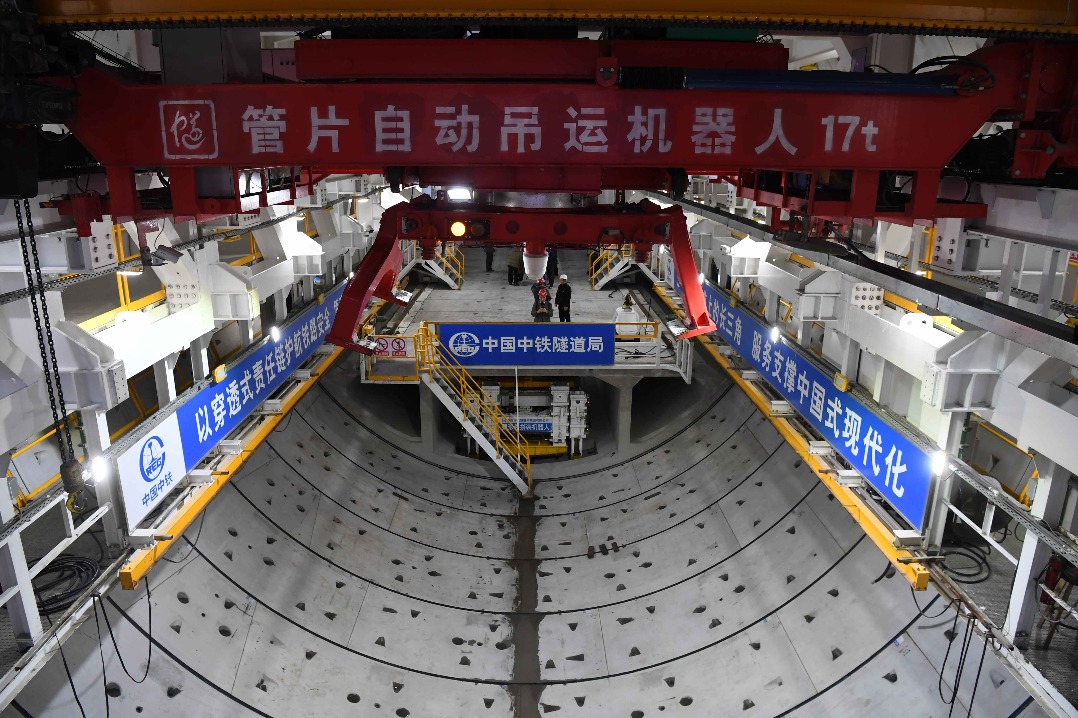Cooperation key to reaching climate goals


China becomes a world leader in clean technology by fighting environmental pollution, sharing experience
Erik Solheim, former executive director of the United Nations Environmental Programme, said he is impressed with China's phenomenal achievements over the past decade in fighting environmental pollution and climate change, and in its march toward sustainable development.
This much is evident to his Twitter followers. Solheim's latest tweets include one about China ranking first globally in planted forests and forest coverage growth, contributing a quarter of the world's new forests in the past decade; one about China producing 60 percent of global solar energy last year and 80 percent of solar panels; and another highlighting the fact that 80 percent of the world's new offshore wind capacity was installed in China last year.
He has also tweeted about Huawei's new electric car factory in Chongqing, which will produce 700,000 vehicles a year, and about the fact that Shenzhen has become the first city in the world to have an entire fleet of fully electric public transportation vehicles — 16,000 buses and 20,000 taxis.
He believes that it's time for the rest of the world to catch up.
For Solheim, who is also the former Norwegian Minister of the Environment and Minister of International Development, China's achievements on the climate and environmental fronts all started with its fight against pollution.
"People wanted to see beautiful skies over their cities," he told China Daily. "The incredibly fast reduction in air pollution in Chinese cities over the last decade shows how fast China can act. This has now spilled over into renewable energy, nature protection, green cities, electric mobility, tree planting and a lot more. Today, China is the world leader in all green technologies."
The latest figures from China's Ministry of Ecology and Environment prove Solheim's observations that the country is rapidly switching to a more sustainable path.
Minister of Ecology and Environment Huang Runqiu told a news conference on Sept 15 that the country's toughest measures and greatest progress on the ecological and environmental front have occurred in the last decade.
He said that thanks to painstaking efforts to combat pollution, clear waters and blue skies have become more commonplace.
While poor air quality used to be a source of frequent public complaints, the average concentration of hazardous airborne PM2.5 particles dropped from 46 to 30 micrograms per cubic meter between 2015 and last year.
About 87.5 percent of days last year were rated as having good air quality, up 6.3 percentage points from 2015, making China the country with the biggest improvement in air quality in the world.
In the last decade, the proportion of water at or above Grade III in the country's five-tier water quality system rose 23.3 percentage points to 84.9 percent, close to the levels in developed countries.
Carbon intensity, or carbon emissions per unit of GDP, has declined by 34.4 percent, with coal accounting for 56 percent of total energy consumption, compared to 68.5 percent a decade ago.
China has phased out over 30 million obsolete and heavy-emission vehicles and has become the world's biggest market for new-energy vehicles as well as the world's largest investor, producer and user of renewable energy.
It has legislated or revised roughly 30 laws and regulations, some of which focused on water resource protection, including the Water Pollution Prevention and Control Law, which was amended in 2017, and the Yangtze River Protection Law, which took effect last year.
James Thornton, founding CEO of Client-Earth, a global public interest law firm in London, has also been a keen observer and participant in China's fight against environmental pollution and climate change.
In TED talks ahead of COP26 in Glasgow a year ago, Thornton talked about how he has been invited by central authorities, among them the Supreme People's Court and the Ministry of Ecology and Environment, to train judges and prosecutors in environmental issues since 2014, and about how impressed he was at the way the government drafted and enforced related laws.
He said that he was surprised by how eager the Chinese were to learn from his extensive environmental litigation experience in Europe and the United States in setting up a system for China, and was even more surprised when his hosts asked him to share his experience of suing governments.
"We want to know about the best climate change cases in the world, because we want to decide some of the best climate change cases here in China," Thornton quoted his host as saying.
"Now, I can assure you that I had never had such a conversation with the Supreme Court in Washington, London or Paris. Certainly nowhere other than Beijing," he told the audience.
ClientEarth has trained 1,500 judges for specialist environment courts in China and 1,200 prosecutors in how to bring environmental cases.
Last year, his office in Beijing received a letter from the prosecutors' office which reads: "Thank you for your cooperation. As a result of it, we have brought, in 2020 alone, over 80,000 environmental cases."
Thornton, who had previously worked for many years for the Natural Resources Defense Council in New York, said that the majority of cases were brought against government departments, adding that prosecutors have set up bureaus all over the country to keep pushing out cases to raise compliance standards across China.
A Bloomberg report, quoting a study released in June by the University of Chicago's Energy Policy Institute, also highlighted China's achievements. It showed that the amount of harmful particulates in the air fell 40 percent from 2013 to 2020, a decrease that could add about two years to average life expectancy if sustained.
The study noted that the 40 percent decline in seven years nearly equals the 44 percent drop in US pollution over 30 years from 1970 after the US Clean Air Act was passed.
"China's success in reducing pollution is a strong indication of the opportunities that could lie ahead for other nations if they were to impose strong pollution policies," researchers concluded.
A survey by China's National Bureau of Statistics last year showed that Chinese public satisfaction about the ecology and environment exceeded 90 percent.
























